
Are you interested in planting flowers that will bloom all spring this year no matter where you live?
Are you unsure what the perfect type of flower is to plant for a spring garden?
Or do you just want to attract pollinators to your flowers and garden this spring?
If so, then you’ll love 20 EASY Spring Flowers to Grow for Pollinators.
And if you continue to scroll you’ll even learn about the best ways to plant your flowers and what to look for when buying Flower seeds and bulbs!
[toc]
1. Begonias
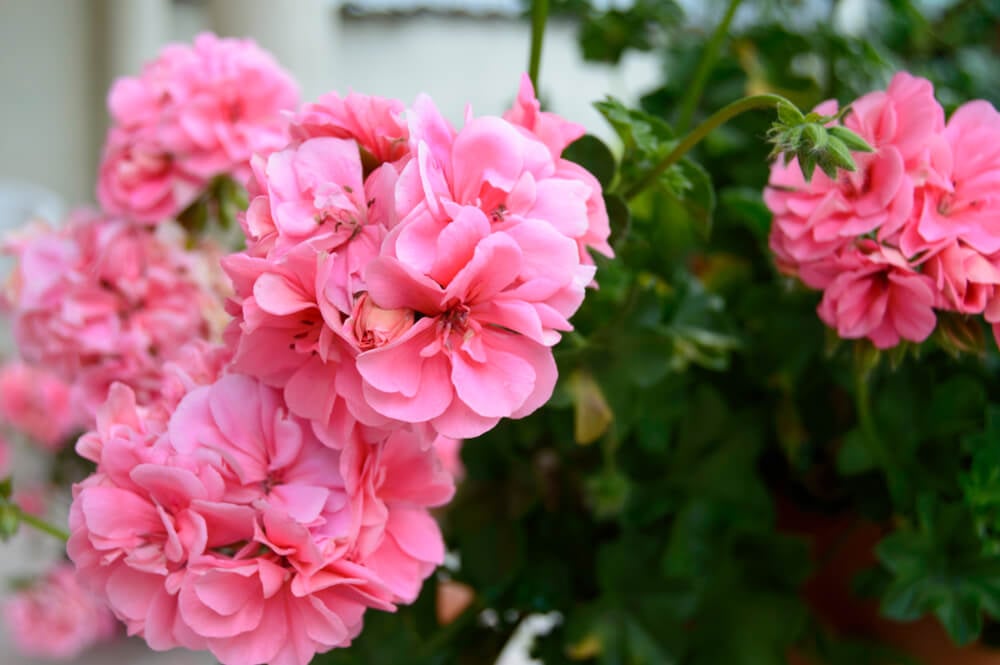
- USDA Hardiness Zone: 8 to 11
- Soil pH: 5.5 to 6.2
- Height x Width: 2 feet x 2 feet
- Maintenance Level: Low
- Light: Partial Sun
- Varieties: Wax, Tuberous, Elatior
One of your favorite that you will grow this spring is the begonia. This type of flower requires very little maitenance.
If you are looking for a flower that requires no deadheading or pruning then look no further.
Expect beautiful blooms of white, pink, and red.
And best of all is that you can move this plant indoors during the winter or dig up the tubular and replant them the following spring.
2. Pansy

- USDA Hardiness Zone: 4 to 11
- Soil pH: 5.4 to 5.8
- Height x Width: 1 foot x 1 foot
- Maintenance Level: Low
- Light: Partial Sun
- Varieties: Blue Moon, Black Accord, Cool Wave
Pansy Flowers is a fan favorite among Gardeners who want to add beauty to their garden during cooler weather.
This type of flower comes in every type of color from yellow to black to white to pink to blue.
This is the perfect flower for hanging baskets, raised garden beds, and ground cover.
Best of all is that this type of flower will even come back in the fall to bloom.
3. Dahlias
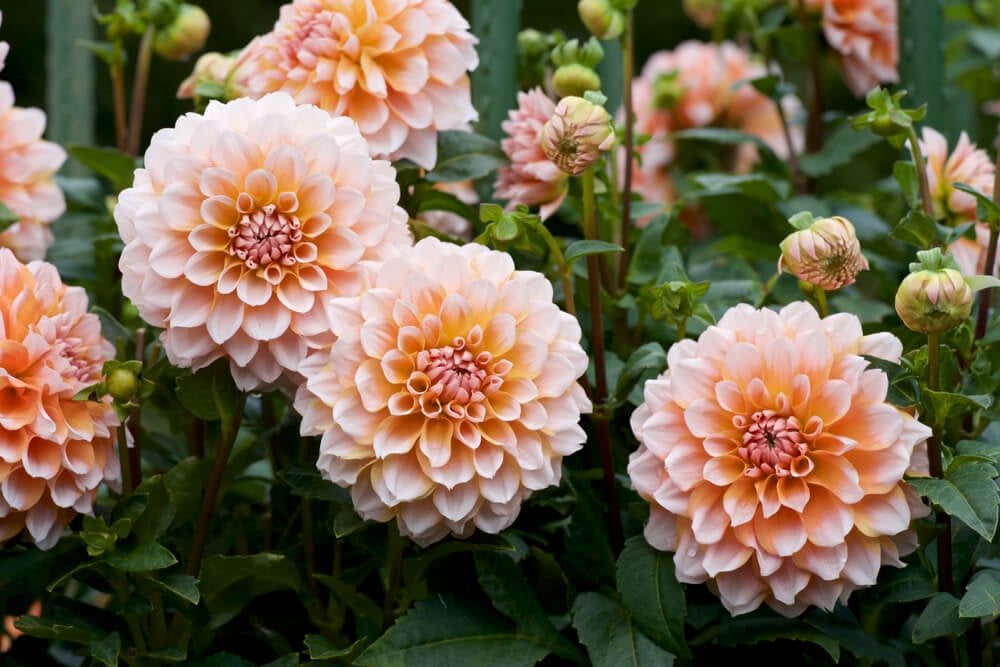
- USDA Hardiness Zone: 3 to 11
- Soil pH: 6.5 to 7.50
- Height x Width: 3 feet x 3 feet
- Maintenance Level: Low
- Light: Full Sun
- Varieties: Cactus, Semi-Cactus, Decorative
If you want an easy to grow spring flower from seed that will add a beautiful lushness to your flower garden then look no further than the dahlia.
Not only this, but Dahlias are an incredible spring flower that can attract many different types of pollinators.
These are easy to grow plants, easy to care, and best of all can be used as an annual or perennial flower.
You’ll love all the different colors this flower comes in and it’s perfect for traditional gardens, pots, raised garden beds, and even hanging baskets.
4. Petunias

- USDA Hardiness Zone: 3 to 11
- Soil pH: 6.0 to 7.0
- Height x Width: 1 foot x 2 foot
- Maintenance Level: Low
- Light: Partial Sun
- Varieties: Grandiflora, Multiflora, Wave
When you think of low-maitenance flowers you should think of petunias.
These flowers are colorful, come in numerous varieties that can be annual or perennial, and are one of the easiest spring and summer flowers to care for.
This type of flower is perfect for hanging baskets, window boxes, planters, raised garden beds, and almost anywhere else you can think of.
- Related: Best Window Boxes for Gardeners
5. Impatiens
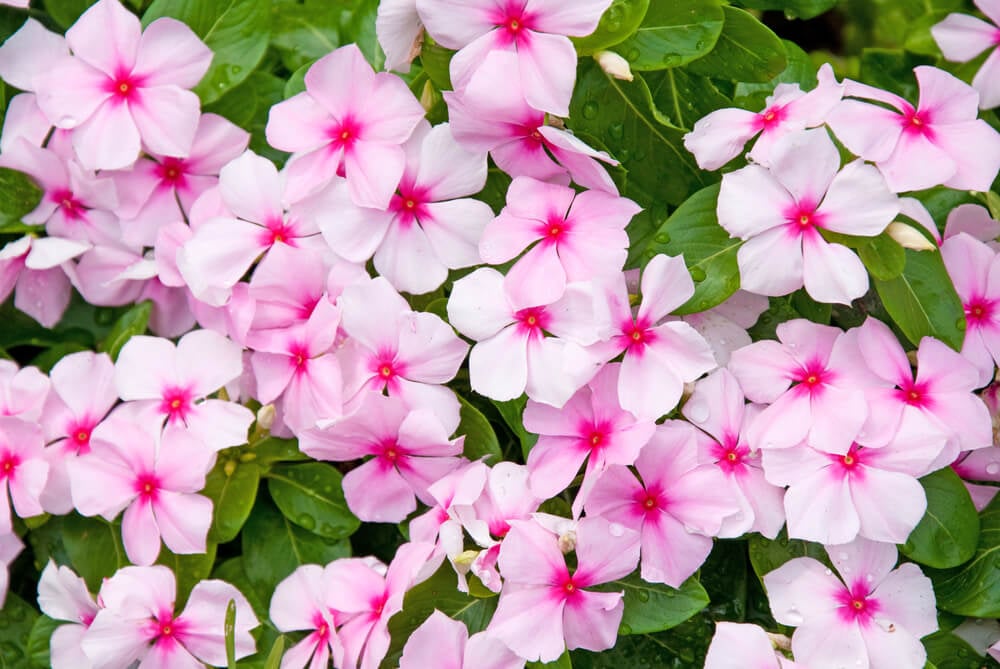
- USDA Hardiness Zone: 9 – 11
- Soil pH: 5.5 to 6.5
- Height x Width: 1 foot x 2 feet
- Maintenance Level: Low
- Light: Partial Sun
- Varieties: Impatiens
Impatiens are flowers that will remind you of petunias and pansies, but do not need as much sun.
This type of flower is soft, beautiful, and comes in many shades of pink, red, and white.
Plant this flower in an area of your yard or garden this receives lots of shade and expect blooms throughout spring and summer.
You can also plant them in hanging baskets or planters that are shaded by your house.
6. Marigold

- USDA Hardiness Zone: 2 to 11
- Soil pH: 5.8 to 6.2
- Height x Width: 1 foot x 1 foot
- Maintenance Level: Low
- Light: Partial Sun
- Varieties: Mexican, Signet, Tagetes
Marigolds are beautiful annual flowers that are perfect for any gardener looking to add color to their garden.
If you live in an area that receives cold nights and even light frosts in early spring or late fall or then you have the perfect flower with marigolds.
Best of all is that you can deadhead your marigold flowers once they die to promote more flower growth.
7. Hyacinth
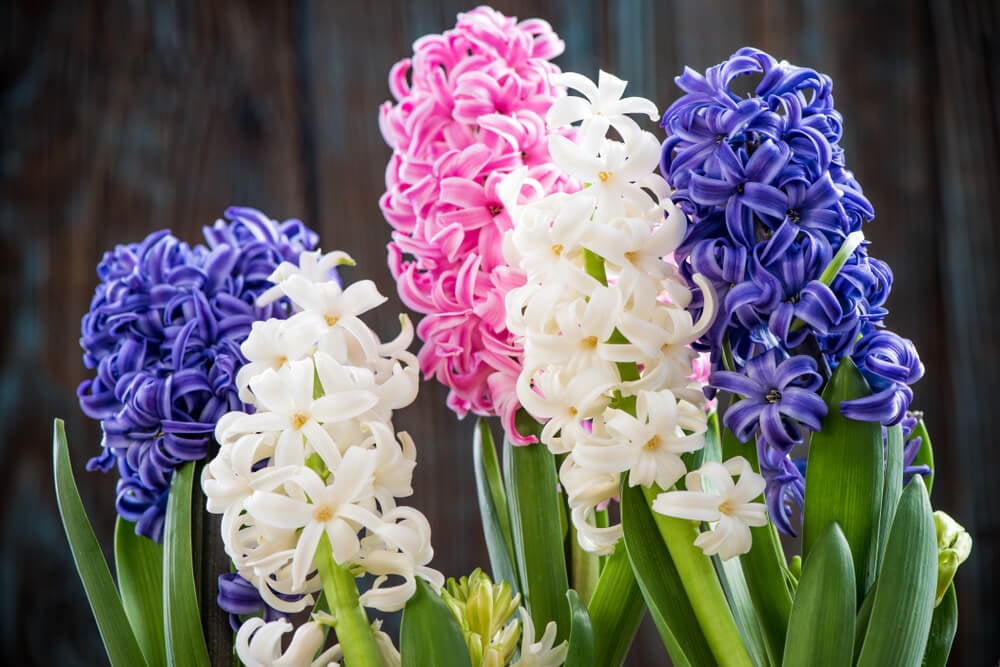
- USDA Hardiness Zone: 4 to 8
- Soil pH: 6 to 7
- Height x Width: 2 feet x 2 feet
- Maintenance Level: Low
- Light: Full-Sun
- Varieties: Berries and Cream, Giant, Gipsy Queen
Hyacinth flowers are my favorite spring perennial ever.
They come in beautiful colors, are easy to grow and maintain, and almost always comes up every year.
Not only this, but pollinators love them. I typically find at least a dozen honey bees hanging around them every day in early spring.
If you want to pollinate your garden then I recommend planting these near fruit trees, vegetables, and even herbs.
And while this flower thrives in full-sun you can plant it almost anywhere in your yard and still have success.
8. Zinnias
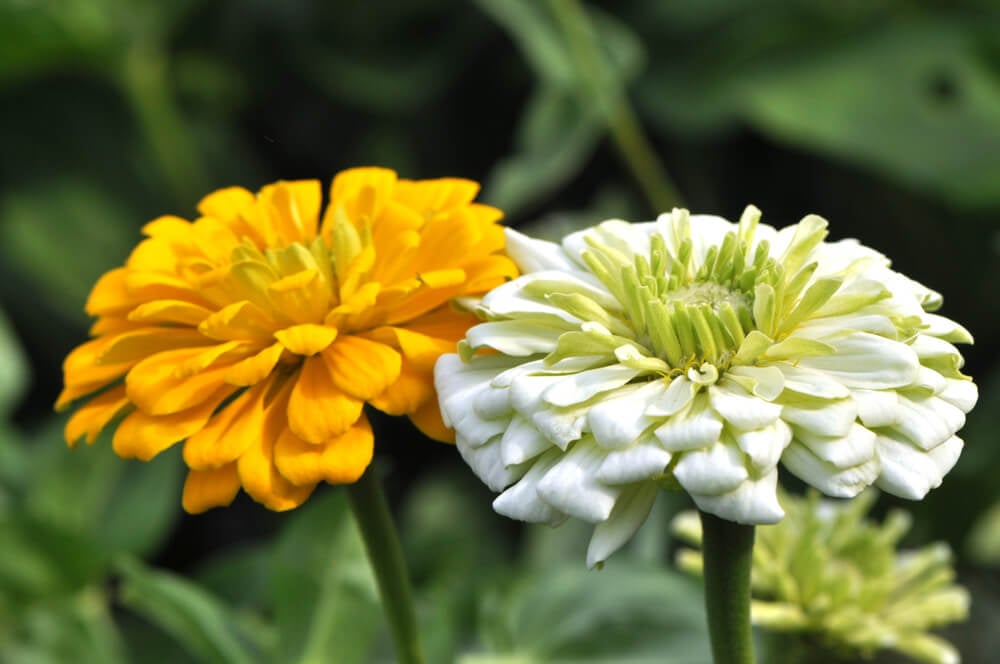
- USDA Hardiness Zone: 3 to 10
- Soil pH: 5.5 to 7.5
- Height x Width: 2 feet x 1 foot
- Maintenance Level: Low
- Light: Partial Sun
- Varieties: Common, Desert
Zinnias are another incredibly easy flower to grow from seed in the winter and to transplant into your flower garden in the spring.
This type of flower is an annual that fits great into raised garden beds, hanging baskets, traditional gardens, and even window boxes. What you’ll love most about this flower though is that it requires no care!
And it is a great way to attract pollinators in the spring and summer. Sometimes you will even attract pollinators with early fall blooms that most gardeners will experience.
- Related: Best Garden Planters for ALL Plants
9. Daffodils

- USDA Hardiness Zone: 3 to 8
- Soil pH: 6.0 to 7.0
- Height x Width: 2 feet x 1 foot
- Maintenance Level: Low
- Light: Full Sun
- Varieties: Wild, Poet, Primrose
Daffodils are your classic spring flowers that fill the city streets and yards of fellow neighbors.
This is a great perennial that attracts pollinators, is easy to grow, and comes in many unique shapes and colors.
While daffodils are perfect for traditional gardens and anywhere in your yard, it is also great in planters, pots, and even in between vegetables and herbs.
- Related: How to Grow Daffodils for Beginners
10. Tulips

- USDA Hardiness Zone: 3 to 8
- Soil pH: 6.0 to 7.0
- Height x Width: 2 feet x 1 foot
- Maintenance Level: Low
- Light: Full Sun
- Varieties: Garden, Parrot, Lady
Tulips may be my favorite annual flower on this list. And it is the most beautiful spring blooming flower.
There are more tulip colors and kinds then you can count. And they have some of the most uses of all the spring flowers on this list.
Plant and grow tulips in raised garden beds, flower gardens, anywhere in your yard, and even in pots. Best of all is that they can be cut right before bloom and blossom indoors.
11. Sunflowers

- USDA Hardiness Zone: 2 to 11
- Soil pH: 6.0 to 7.5
- Height x Width: 8 feet x 3 feet
- Maintenance Level: Low
- Light: Full Sun
- Varieties: Common, Maximilian, Mammoth
Sunflowers may be the most recognizable flower that blooms in late summer and early autumn on this list.
There are over 15 different types of sunflowers and they can grow anywhere from 3 feet tall to 15 feet tall!
The best part about this type of flower is that the seeds have many uses, including food for humans and other animals alike.
12. Virginia Bluebells
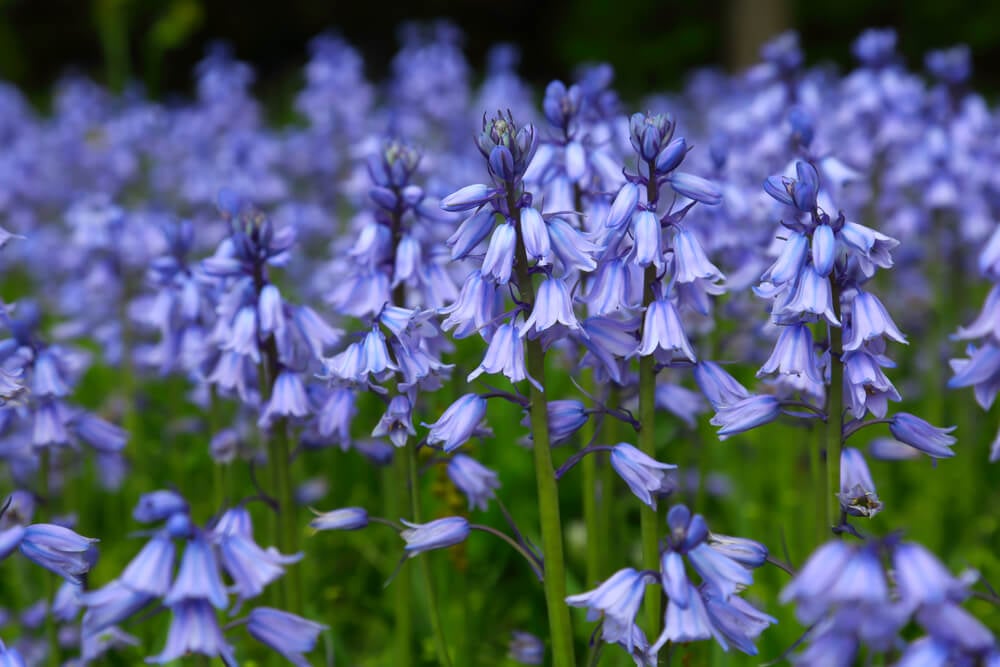
- USDA Hardiness Zone: 3 to 9
- Soil pH: 5.8 to 6.2
- Height x Width: 2 feet x 2 feet
- Maintenance Level: Low
- Light: Partial Sun
- Varieties: Virginia Bluebells
Virginia Bluebells are one of the most amazing flowers you will ever see, but the problem is they grow in a very particular part of land.
You can find Virginia Bluebells naturally by rivers in the shade. You can also grow them in your garden in well-draining soil with lots of water and partial-sun.
Best of all is that these flowers are great complements with other spring flowers and even early bloomers!
13. Coneflower (Echinacea)
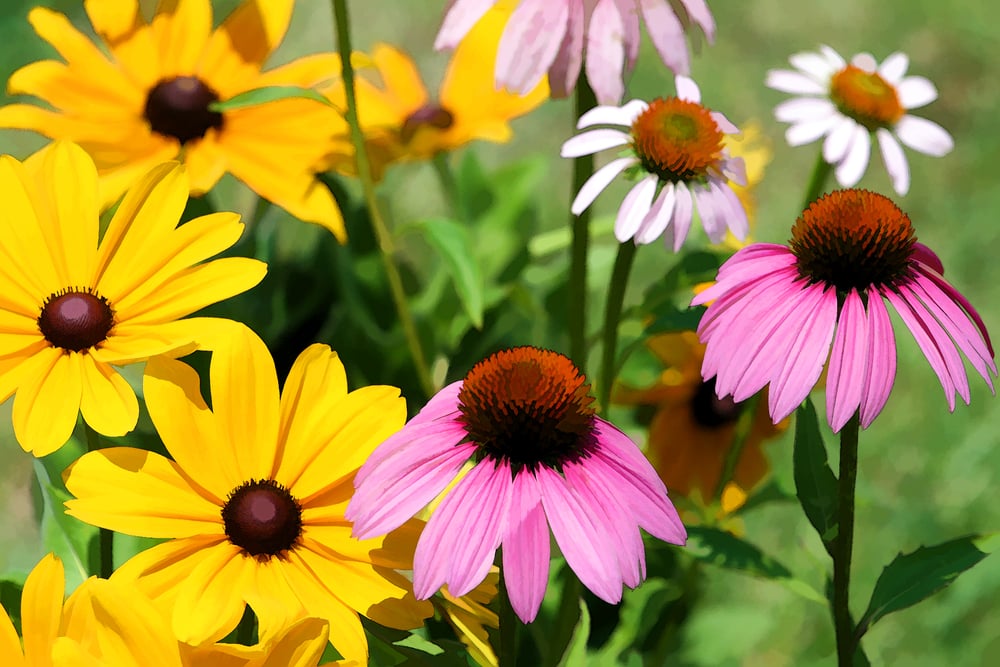
- USDA Hardiness Zone: 3 to 8
- Soil pH: 4.5 to 7.5
- Height x Width: 2 feet x 2 feet
- Maintenance Level: Low
- Light: Full Sun
- Varieties: Coneflower
If you are interested in growing a flower that will bloom from spring to fall then look no further than the coneflower.
The coneflower comes in many shapes, sizes, and colors and is one of the best perennial plants for attracting pollinators all year.
And this is a great flower for raised garden beds, traditional gardens, and in garden pots.
Best of all is that this plant has many medicinal purposes and is great in tea.
14. Rudbeckia (Black-Eyed Susan)

- USDA Hardiness Zone: 4 to 9
- Soil pH: 6.8 to 7.2
- Height x Width: 2 feet x 2 feet
- Maintenance Level: Low
- Light: Full Sun
- Varieties: Indian Summer, Prarie Sun, Moreno
Rudbeckia is more commonly known as the Black-Eyed Susan and is the perfect flower for spring, summer, and flower beds.
This type of flower is perfect in drought-resistant areas, should be thinned out in the spring, and can be an annual or perennial plant depending on where you live.
Not only this, but this flower is a great plant to attract pollinators and is deer, rabbit, and squirrel resistant.
15. Snapdragon
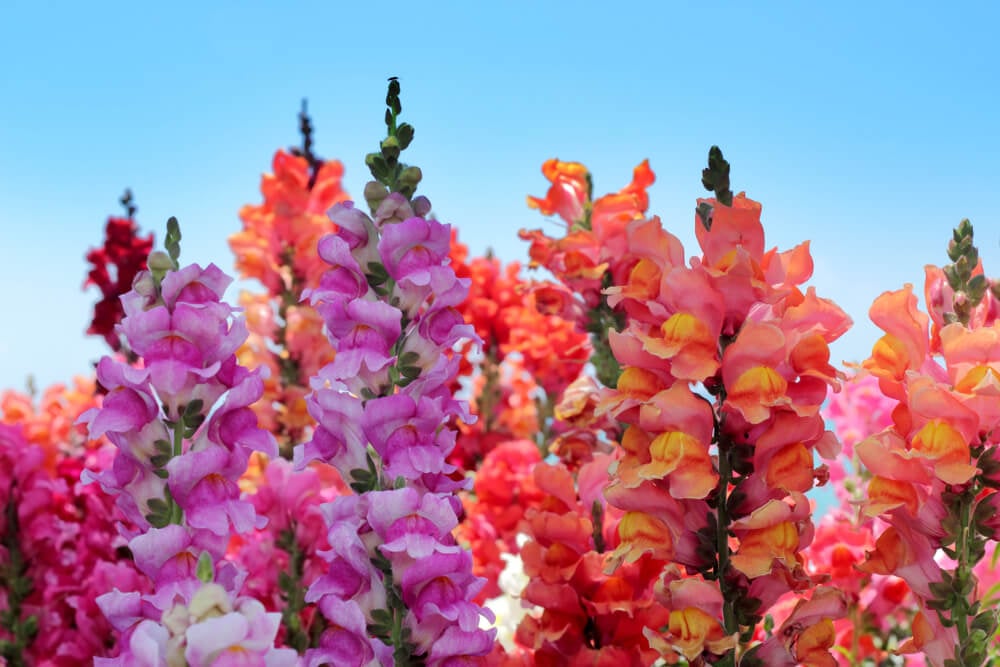
- USDA Hardiness Zone: 8 to 9
- Soil pH: 6.2 to 7.0
- Height x Width: 3 feet x 2 feet
- Maintenance Level: Low
- Light: Full Sun
- Varieties: Snapdragon
Snapdragons are beautiful, fragrant flowers that have mouthlike petals.
These are another perfect type of flower that fits in with any type of flower in a garden bed, pots, or traditional flowers.
Best of all, when harvested this flower is perfect for wedding boutiques, dinner settings, and so much more.
16. Geraniums
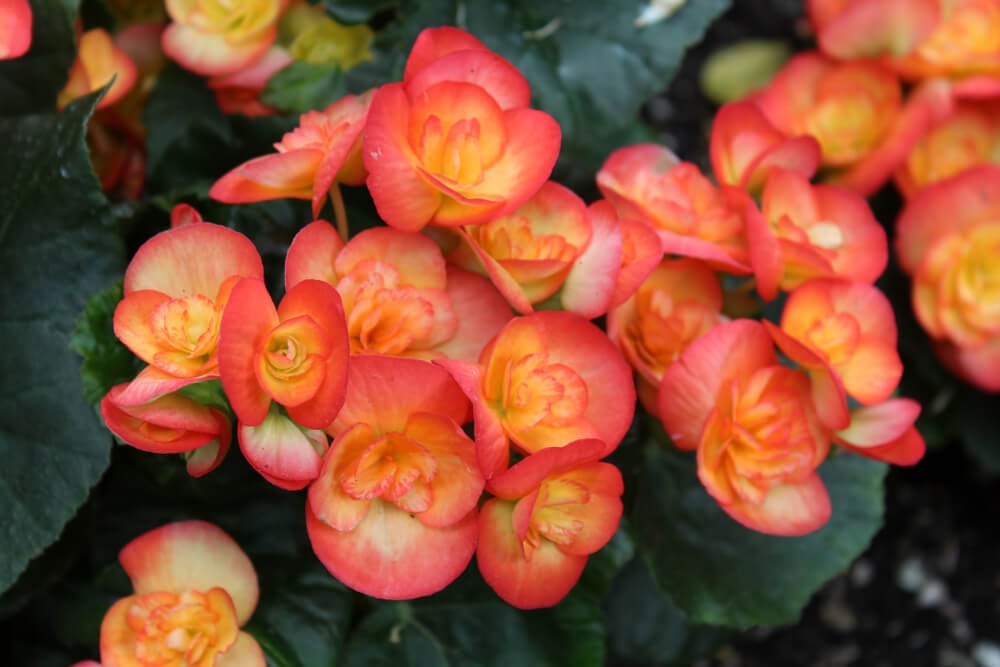
- USDA Hardiness Zone: 10 to 12
- Soil pH: 6.0 to 6.5
- Height x Width: 2 feet x 2 feet
- Maintenance Level: Low
- Light: Partial Sun
- Varieties: Geraniums
Geraniums are beautiful flowers that grow great indoors and outdoors.
This type of flower is perfect for dressing up your walkway, front porch, yard and even house!
If you pot this plant it will bloom for months at a time if you move it indoors!
17. Cosmos

- USDA Hardiness Zone: 2 to 11
- Soil pH: 6.0 to 6.8
- Height x Width: 2 feet x 1.5 feet
- Maintenance Level: Low
- Light: Full Sun
- Varieties: Garden, Chocolate, Sulfur
The Cosmos flower is the perfect flower for a spring and summer flower garden. They smell great, look great, and bloom all year.
Expect this flower to come in shades of pink, white, and purple and attract bees and butterflies alike.
Best of all is that if you cut these flowers early on you will get bigger and more flowers throughout the summer faster.
18. Butterfly Bush
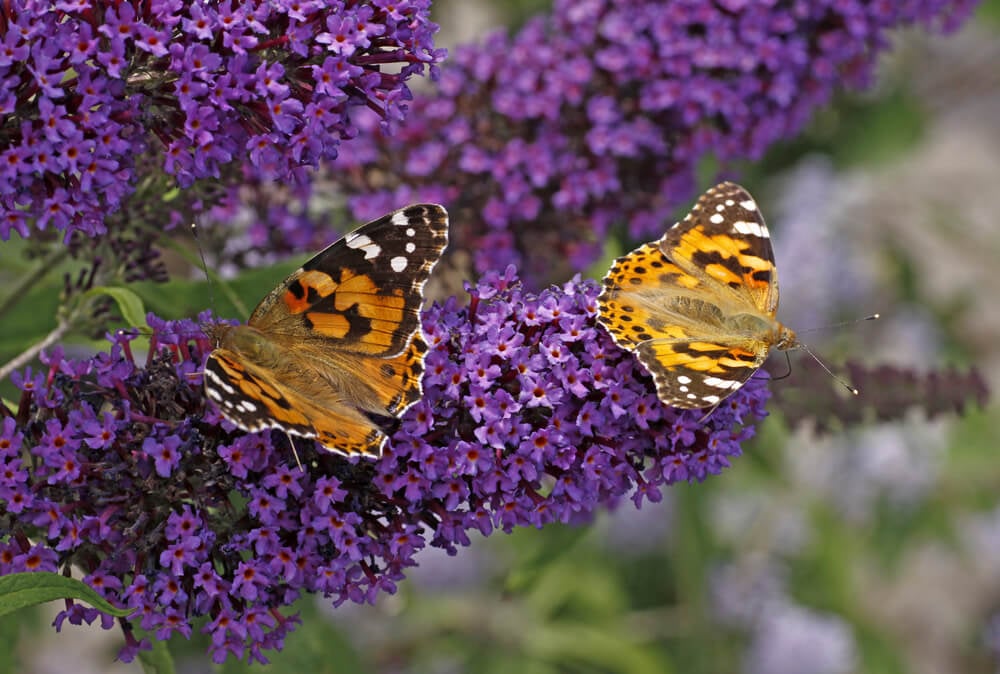
- USDA Hardiness Zone: 5 to 9
- Soil pH: 6.0 to 7.0
- Height x Width: 8 feet x 8 feet
- Maintenance Level: Low
- Light: Full Sun
- Varieties: Butterfly Bush
The butterfly bush is one of the most famous ways to attract butterflies to your garden this year.
Butterfly bushes comes in shades of purple, red, and pink. And these plants grow fast and large.
If you have an area in your garden or yard that needs a large plant that requires no maitenance and little water then you should use the butterfly bush.
This is not a great plant for small places, pots, and even raised garden beds.
19. Cornflower

- USDA Hardiness Zone: 2 to 10
- Soil pH: 6.0 to 7.0
- Height x Width: 1 foot x 1 foot
- Maintenance Level: Low
- Light: Full Sun
- Varieties: Black Ball Rich Chocolate Shade, Blue Diadem, Jubilee
If you read any book or online guide for attracting pollinators you will find cornflowers at the top of the list.
This flower is beauty, hardy, and blooms all spring and summer.
This flower not only attracts pollinators, but it is perfect for indoors, pots, and looks great in a “wild” setting.
20. Phlox
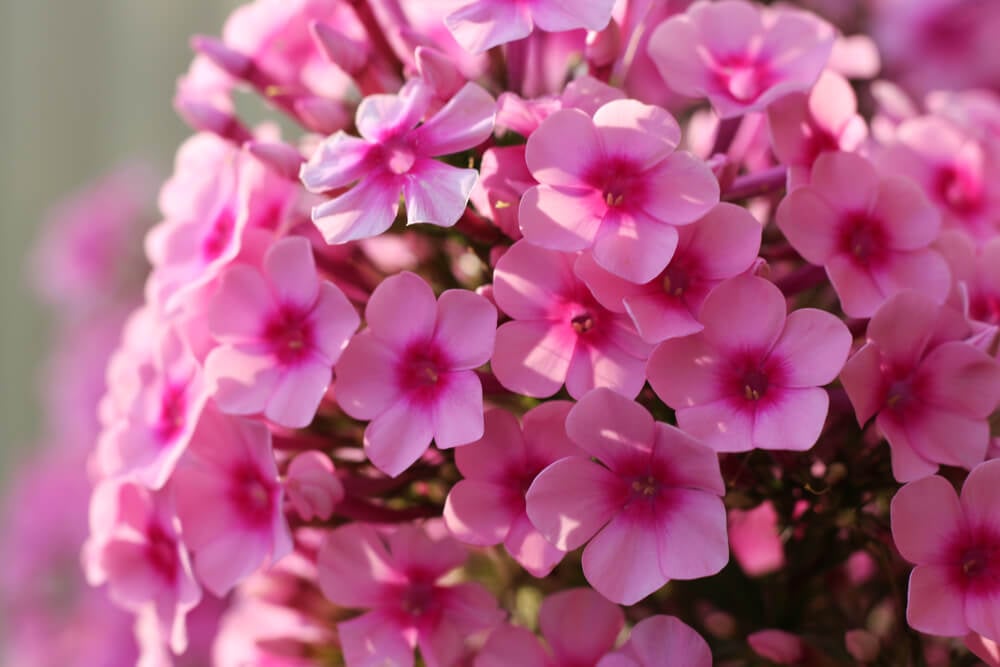
- USDA Hardiness Zone: 4 to 8
- Soil pH: 6.8 to 7.7
- Height x Width: 1 foot x 3 feet
- Maintenance Level: Low
- Light: Full Sun
- Varieties: Garden, Creeping, Moss
The phlox flower is a great annual flower that can be grown greatly in hardiness zones 4 to 8.
While it is hard to find, this annual flower has beautiful pink, white, salmon, and red colors.
This flower should be well-watered, does not do great in the winter, but thrives in containers and even indoors.
Frequently Asked Questions (7 Questions)
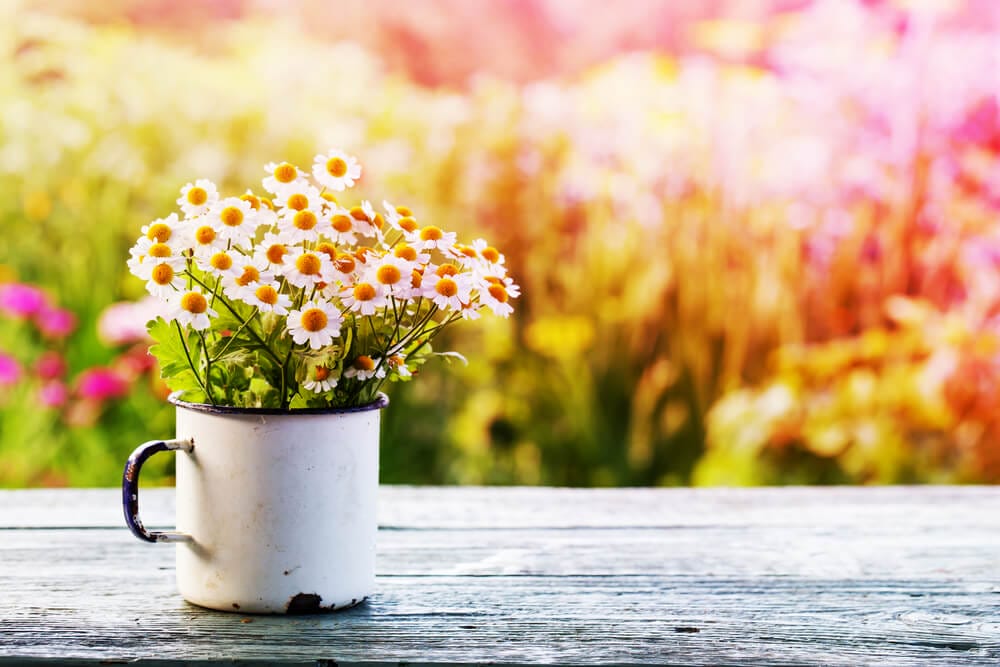
1. How Do I Plant Spring Flowers?
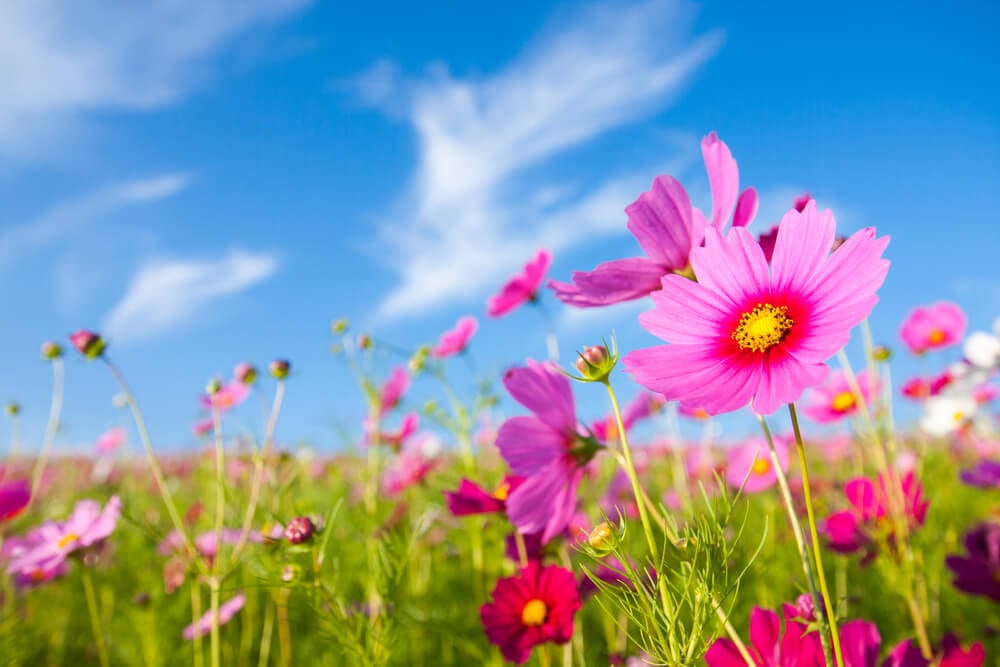
Planting Spring Flowers is relatively easy.
Assuming you are just planting a flower plant all you need to do is dig a hole approximatley 6 – 8 inches deep.
Then apply a cup of flower garden soil. Place your flower plant into the hole. Then cover it with your soil.
Next, apply flower fertilizer and water it for 15-20 seconds. Once a week you will want to water your flowers if they do not receive rain.
If you are planting flower bulbs you will want to dig a hole 6 – 8 inches deep.
Plant your bulbs with the “pointy end” up. Then cover it with soil and water it for 15 – 30 seconds.
After, do not water the bulbs as this can cause root rot and other diseases.
For Beginner Gardeners, I recommend not planting flower seeds as they take too much time, effort, and money. And the success rate on growing flowers from seeds is minimal.
2. When Do I Plant Spring Flowers?
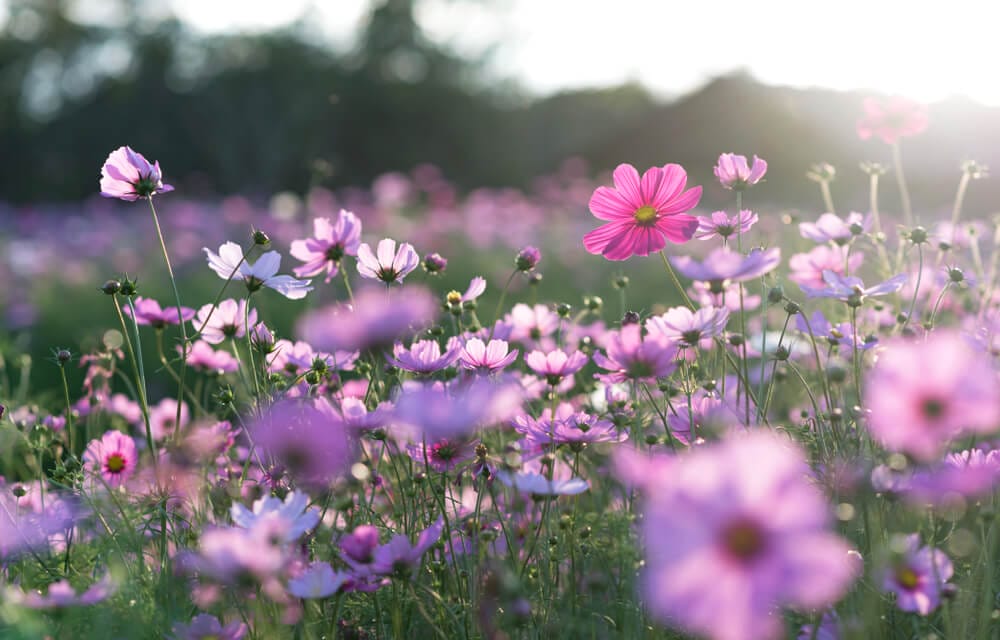
Depending on how you plan on planting spring flowers you have several options on when to plant your spring flower garden.
If you plan on growing your spring flowers from seed then you should start your seeds about 6-8 weeks before you transplant them into your flower garden.
This usually means starting your flower seeds sometime in January or February.
If you plan on using bulbs then you should plant them in early fall and they will bloom in early to late spring.
And if you plan on using actual flower plants then you can plant them after the first frost, approximately 2-3 weeks before you want them to bloom.
3. How Do You Attract Pollinators?

Attracting Pollinators to your garden may sound complex, but it doesn’t have to be.
All you need to do to attract pollinators to your garden is to plant flowers that they like.
For Bees I recommend planting:
- Coneflower, Daisy, Cornflower, Black Eyed-Susan, Pansy
For Butterflies I recommend planting:
- Petunias, Calendula, Coneflowers, Cosmos, Butterfly Bush
For Hummingbirds I recommend planting:
- Pansies, Coneflowers, Petunias
4. What is a Soft Perennial and an Annual Flower?

One of the biggest questions gardeners have when choosing a flower is whether they should buy a perennial or annual.
Annual flowers bloom only once and need to be rebought and replanted yearly. This type of flower is a great fit for raised garden beds, hanging baskets, and garden containers.
Perennial flowers bloom every year and is a great fit for traditional gardens, anywhere in your yard, and even raised garden beds.
And then there are soft perennial flowers.
These flowers will bloom every year in warmer weather climates. At the same time, these flowers will bloom only once and act more like annual flowers in colder weather climates.
5. Where Do I Buy Inexpensive Fall Flowers?

Annual flowers can be very expensive to buy every year.
And flower bulbs and seeds can take time and effort to have success and there is still a likelihood that not all of your flowers with sprout or bloom.
If you are looking to buy inexpensive annual flowers, bulbs, and seeds then I recommend Amazon.
This will give you the widest variety of flowers at the most inexpensive price.
6. What Colors Should I Incorporate into My Fall Flower Garden?
Spring Flower colors are incredibly important when deciding garden designs and ideas.
Below, are some color arrangements that I recommend when planting your spring flower garden:
- Classic Spring Colors: Red, Yellow, White, and Purple
- Bright Colors: Orange, Yellow, Bright Red
- Soft Colors: White, Light Purple, Light Pink
7. What Type of Garden Design Should I Use?

Garden design is the most complex and most rewarding part about flower gardening.
When deciding what your garden design should be there are several factors to consider:
- What Size Flower Garden Do You Want
- The Amount of Initial Work and Yearly Maintenance You Want To Do
- What Flowers You Want to Grow
- How Much Sunlight, Water, and Maintenance will be Required
- What Tools are Needed
- Whether you Want to Grow Your Flowers in a Traditional Garden, Raised Garden Bed, Hanging Baskets, Garden Containers, or just In You Yard
And if you like taking care of flowers or want to pursue a career in taking care of flowers then browse jobs on a flower farm.